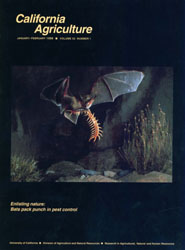All Issues

Enlisting nature: Bats pack punch in pest control
Cover:
Pallid bats, such as the one shown, feed on grasshoppers, beetles, potato bugs and other invertebrates such as scorpions and centipedes. These bats fly close to the ground, often alighting on the ground or on trees to capture their prey... Photo by Merlin D. Tuttle, Bat Conservation International
January-February 1998
Volume 52, Number 1
Volume 52, Number 1





